|
 Venus Figurines:
Venus Figurines:
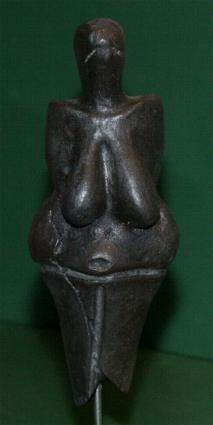
Extract - 'Archaeologically they are known
from the earliest horizons of the Aurignacian and extend to the end of the
Magdalenian. Venus figurines have been found in Britain, France, Italy,
Spain, Austria, Germany, Czechoslovakia, the Ukraine, and as far east as
Lake Baikal... In appearance most are plump little creatures with
exaggerated female characteristics: large breasts, thighs and buttocks. Many
are carved from mammoth tusks, but one of the best known is made of
limestone and generally known as the Venus of Willendorf'
(1)
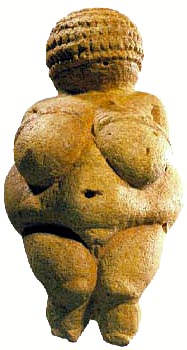
|
Venus Figurines from Around the World: |
'Venus figurines' - is an umbrella term
for a number of prehistoric statues of women sharing common
attributes from the Aurignacian or Gravettian period of the upper
Palaeolithic, found from Western Europe to Siberia. These items were
carved from soft stone, bone or ivory, or formed of clay and fired.
The latter are among the oldest ceramics known. In total, over a
hundred such figurines are known; virtually all of modest size,
between 4 cm and 25 cm in height. (Ref: http://en.wikipedia.org/wiki/Venus_figurines)


The Venus of Laussel, France:
Fashioned on limestone approximately 20,000 years ago
and painted with red-ochre paint.
It has been suggested that the 13
notches on the 'horn' she is holding represent either the number of moons or
the number of menstrual cycles in a year (or both).
The Oldest Venus Figurine Yet Found:
The oldest yet discovered venus figurine
has been recovered from the archaeological cave site of Hohle Fels, Germany,
and reported in the May 14, 2009, issue of Nature
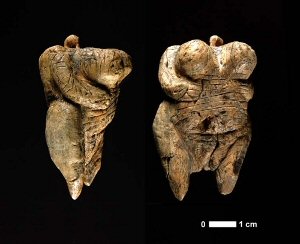
Hohle Fels is an Upper Paleolithic
cave site in the Swabian Jura of southwestern Germany, and it is known
for mammoth ivory carvings and the evidence of their manufacture,
dated to the Aurignacian, between about 31,000 and 33,000 years ago.
Excavator Nicholas Conard at the University of Tubingen has recovered
three other ivory carvings, including a waterbird, a horse's head, and
a strange half-human, half lion figurine.
Conard discovered the venus figurine
illustrated above, and has suggested, based on the stacked five
Aurignacian layers above it that it dates to the earliest Aurignacian
period of about 35,000�40,000 years ago. The next oldest venus
figurine is from Dolni Vestonice in the Czech Republic, between about
28,000 and 31,000 years ago.
Other Venus figurines:
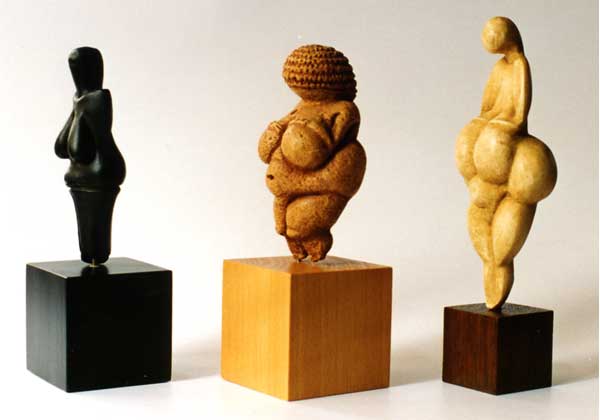
Three European Venus figurines from the
ice-age of ca. 25,000 years ago. From left to right: Venus of
Dolni-Vestonice, Czech, burnt clay. Venus of Willendorf, Austria, Chalk.
Venus of Les pugue, France, mammoth ivory.
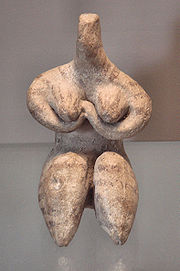
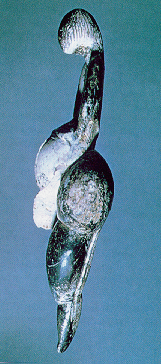
Female statuettes from Samarra c. 6,000
BC (left), and Le Pugue (right).
The Kostenki Figurines: Siberia,
Russia
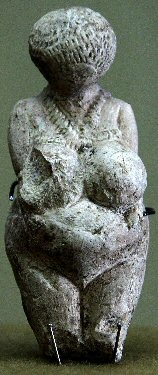
(Left: 23,000 BC. Limestone. H 10.2 cm.)
This Venus figure from Kostienki made of mammoth bone shows the
characteristic pregnancy, well developed buttocks and pendulous
breasts of many such statues. In the rear view she can be seen to be
wearing a fringe or girdle.
The
faceless head bends towards the chest while the arms are pressed to
the body with hands on the belly. Covering the surface of the head are
rows of incisions indicating a
hair style or
cap. Relief work in the form of a tight plait convey a
breast ornament tied up at the back. There are
bracelets on the arms. Photo: J Jelinek, 'The Evolution of
Man'.

Also
found at the Russian site of Kostenki in 1988, this is by far the
largest such object known from the ice age. The height of the
surviving fragment is 13.5 cm (5.5 inches) It is noteworthy not only
for its massive size and the prominent navel, but also for the
bracelets on the wrists, which appear to be joined together at the
front like a pair of handcuffs.

Venus of Gagarino, Ukraine:
(Height 5.8 cm)
Gagarino is located on the right bank of the Don River about five
kilometres north of the junction of the Sosna, a tributary stream.
Here peasants discovered a house pit while excavating a silo trench.
Unfortunately, the trench cut through the centre of the house pit
along its major axis and presumably destroyed the hearth and entrance.
Zamiatinine (1934) who excavated this site during 1926 - 1929, found a
house pit roughly oval in outline about 5.5 metres long and 4.5 metres
wide. The floor was located 40 to 60 cm below the occupational
surface. The walls of the pit were lined with the long bones of
rhinoceros and mammoth, including the tusks and lower jaws of the
latter, as well as with sandstone slabs. The wealth of material
remains found in this one house pit is seen in the recorded finds of
some six hundred flint implements, over a thousand blades, and
proportionately large numbers of cores, waste flints, artefacts of
bone as well as several "venus" figurines .
On the
Island of Malta, which has several strong indications of a prehistoric
female worship, a number of small 'Venus' figurines have been found, along
with a 'life-size' figure, which is more often referred to as the
'mother-earth-goddess' figure.
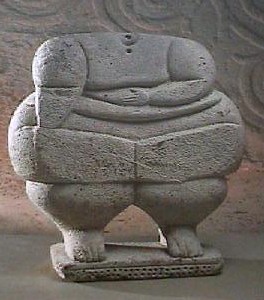
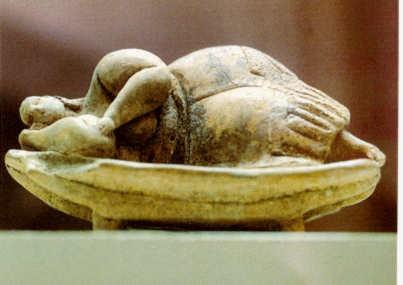

Most of the Venus figures in Malta were
found in or around temples, reinforcing the suggesting of an association
with religious worship.
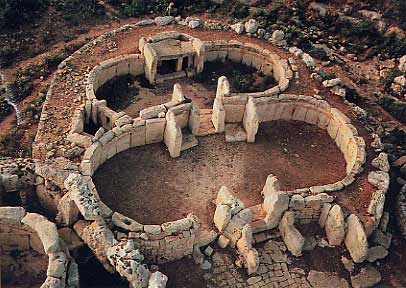
The shape of the temples themselves has been likened to
the shape of the earth-mother-goddess figures. The same observation has
been made at certain Neolithic structures on the Orkney Islands.

The dominant position of the huge female-goddess figure
inside the entrance to the
Hal Tarxien temple reinforces the idea
that they were an important part of ceremonial procedure. The top half is
now missing.
(More about Malta)
|
Venus Figurines as Representations of the Earth-Mother: |

The Earth-mother figurine above is from
Catal Huyuk in Turkey, and shows
similarity to other more recent earth-mother figures found in Europe, such
as the Cybele of Minoan Greece and Britannia below.
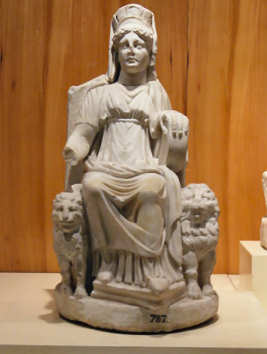

(Earth-mother-earth)
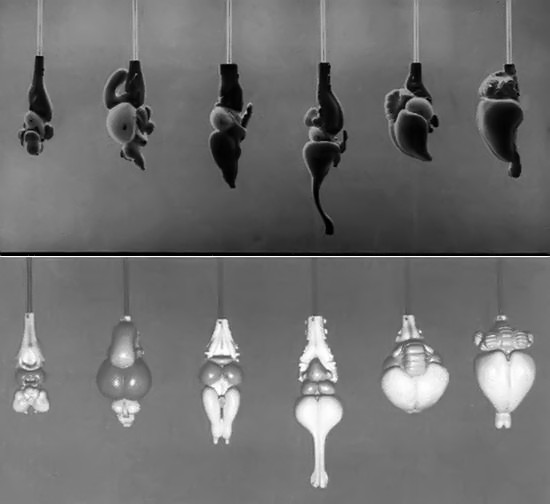
Lateral and dorsal
views of animal brains (not proportionally sized), from
left: larva of lamprey, trout, frog, alligator, pigeon,
rabbit.

The similarity between animal brains and some
of the distorted Venus figurines lead to the possibility
that some of the 'figurines' might in instead be life-sized
animal brain-images.
It is proposed that
ancient shaman carved brain replicas that encoded
characteristics of the totem animals of whose brain they
copied.
This figure (right) from
Easter Island bears some resemblance, also, to the lateral
view of a turtle's brain. Much art of the Pacific Islands
may well lend itself to this sort of physiologic analysis.
(Link
to Full Article)
(Earth-Mother-Earth)
(Earth-Navels)
(Palaeolithic
Homepage)
|
|